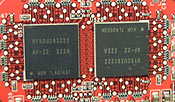Because the GPU would only render 4 pixels in
single texture environments, coupled with the restrictive memory bus, the
GeForceFX 5800/5800 Ultra was actually quite slow. On a side note,
because of the higher core speed (500 MHz for NV30, 450 for NV35), the GeForceFX
5800 Ultra has a higher theoretical fill rate than the GeForceFX 5900
Ultra. However, the FX 5800 Ultra is bandwidth limited so ultimately the FX
5900PV Ultra is indeed faster.

nVIDIA did not "fix" the single texture issue as modern games
all take advantage of multi-texturing. The memory bus did get an overhaul
however. With the NV35, nVIDIA doubled the memory bus from 128bit to 256bit, and
despite having the memory run slower (1 GHz DDR2 on the NV30, 850 MHz DDR for
NV35) the GeForceFX 5900 Ultra has more bandwidth (16GB/s vs 27.2
GB/s).
If you'd like to see some image quality
comparisons between GeForceFX 5900 Ultra and Radeon 9800 Pro, please take a look at our Albatron GeForceFX 5900PV
videocard review.
Overclocking the nBox:
Knowing
the overclocking results we witnessed with the Albatron GeForceFX
5900PV we expected similar speeds from the MSI FX5900U-VTD256 Ultra, after
all a GeForce is a GeForce is a GeForce.
Starting
at 450 MHz core speed I slowly raised the core speed 5 MHz at a time,
and easily passed 475 MHz. While overclocking the core alone
we actually got up to 510 MHz! However, as with the Albatron GeForceFX 5900PV, when
we overclocked the memory it decreased our max core overclock.
Because
the MSI FX5900U-VTD256 Ultra uses
the same 2.2ns Hynix BGA DRAM as the Albatron GeForceFX 5900PV we were expecting
similar results from it on the memory side of things. Amazingly, the
memory reached 1 GHz by itself.... however once we included a core overclock it
severely slowed the memory down.
I
know nVIDIA mean with their thermal management, but it makes finding the
maximum speed of any given FX5900 much harder. After about an two hours of
frustrating tinkering we found that if we clocked our card at 489 MHz core and
951 MHz memory we'd get optimal performance.
| pcstats test system
specs: |
|
|
computer hardware: |
|
| processor: |
pentium 4 2.8 ghz |
| clock speed: |
21 x 133 mhz = 2.8 ghz |
| motherboards: |
msi gnb max-fisr |
| chipsets: |
e7205 |
| videocard: |
ati radeon 9800 pro (380/680)
ati radeon 9700 pro (325/620)
albatron geforcefx 5900pv (400/850)
msi g4ti4600-td (300/650)
gigabyte radeon 9600 pro (400/600)
albatron geforcefx 5600p turbo (325/600)
msi nbox fx5900u-vtd256 ultra (450/850)
msi nbox fx5900u-vtd256 ultra (489/951) |
| memory: |
2x 256mb corsair xms3500 cas2 |
| hard drive: |
40gb wd special
ed. |
| cdrom: |
nec 52x cd-rom |
| floppy: |
panasonic 1.44mb floppy drive
|
| heatsink: |
avc sunflower |
| powersupply: |
vantec 470w stealth psu |
| software setup |
windowsxp build 2600
intel
inf 5.10.1012
catalyst 3.5
detonator 44.03 |
| workstation benchmarks |
3dmark2001se
3dmark03
aquamark
codecreatures
commanche 4
gun metal 2
quake iii arena ver 1.17
ut2003
aa test, af and aa+af
test
3dmark2001se
quake iii arena |
